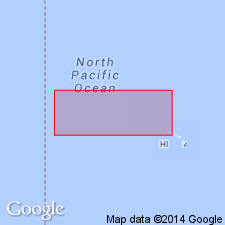
- Usage in publication:
-
- Aliamanu tuff*
- Modifications:
-
- Original reference
- Dominant lithology:
-
- Tuff
- AAPG geologic province:
-
- Oahu
Summary:
Aliamanu tuff. Included in lower part of Honolulu volcanic series [q.v.]. Is lower tuff exposed near Aliamanu Crater, from which it was erupted. [Replaces Lower Salt Lake tuff of Wentworth (1926), according to H.T. Stearns.] Composed of water-laid gray to black or grayish-brown tuff, rounded gravel and (in tunnels) large vesicular bombs and spatter. Tuff is 10 feet thick in geologic section near Aiea railroad station. Separated from overlying Salt Lake tuff by red soil. Overlies older alluvium. Assigned to Kaena stand of sea on basis of terraces. Age is considered middle(?) and late Pleistocene.
[Type locality not designated.] Named from Aliamanu Crater, [Aliamanu Military Reservation, approx. Lat. 21 deg. 21 min. 35 sec. N., Long. 157 deg. 54 min. 43 sec. W., Pearl Harbor 7.5-min quadrangle, Honolulu Co.], Island of Oahu, HI.
[Additional locality information from USGS GNIS database and USGS historical topographic map collection TopoView, accessed on July 20, 2023. Hawaiian spelling: Āliamanu Crater (U.S. Board on Geographic Names, 2000).]
Source: US geologic names lexicon (USGS Bull. 896, p. 32); supplemental information from GNU records (USGS DDS-6; Menlo GNULEX).
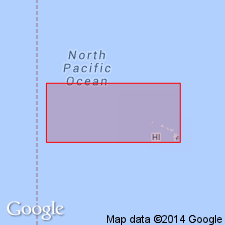
- Usage in publication:
-
- Aliamanu tuff*
- Modifications:
-
- Age modified
- AAPG geologic province:
-
- Oahu
Summary:
Pg. 77. Aliamanu tuff. Included in lower part of Honolulu volcanic series. Is a water-laid gray to black or grayish-brown tuff containing numerous olivine crystals and some augite and magnetite, and also rounded gravel and sand; partly deposited by mud flow. Contains vegetation molds but no identifiable fossils. On p. 76, authors state "[Aliamanu basalt of Stearns, 1940] appears to be lava erupted at the close of the explosive phase of the Aliamanu vent, hence is correlative with the Aliamanu tuff." Age is Pleistocene.
Exposed intermittently over area of 3 sq mi east of Pearl Harbor, southwest of Koolau Range about 17 mi west of Makapuu Head.
Source: US geologic names lexicon (USGS Bull. 1200, p. 51); GNU records (USGS DDS-6; Menlo GNULEX).
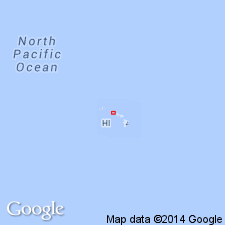
- Usage in publication:
-
- Aliamanu tuff*
- Modifications:
-
- Age modified
- AAPG geologic province:
-
- Oahu
Summary:
Garnet-bearing xenoliths previously known to occur in Salt Lake tuff, Oahu, have been found in Aliamanu and Makalapa tuffs as well. Xenoliths represent fragments of rocks that formed at considerable depths in mantle. Origin of xenoliths is integral part of origin of Honolulu volcanic series. Age of series is considered to be late Pleistocene and Recent.
Source: GNU records (USGS DDS-6; Menlo GNULEX).
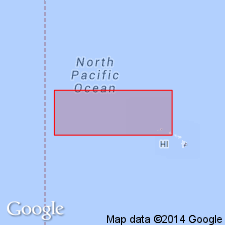
- Usage in publication:
-
- Aliamanu Tuff*
- Modifications:
-
- Age modified
- AAPG geologic province:
-
- Oahu
Summary:
"If this rock can be correlated with the 31-foot-thick flow at the base of the Salt Lake Tuff below the present-day bottom of Aliamanu Crater (Stearns, 1946 p.55 [his Aliamanu basalt]), this dates the period of eruption in Aliamanu Crater from which the water-laid cinder [Aliamanu School Tuff] below the Salt Lake Tuff may be derived." A 467,000 to 400,000 yr B.P. age places eruption during Yarmouth Interglacial.
Source: GNU records (USGS DDS-6; Menlo GNULEX).
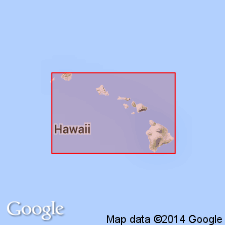
- Usage in publication:
-
- Aliamanu Tuff†
- Modifications:
-
- Abandoned
- AAPG geologic province:
-
- Oahu
Summary:
Aliamanu Tuff (Stearns, IN Stearns and Vaksvik, 1935) and Aliamanu Basalt (Stearns, 1940) are abandoned as formally named units and renamed Aliamanu flow (and associated cone), informal unit of Honolulu Volcanics. Honolulu Volcanics is assigned Pleistocene and Holocene(?) age [but flow is most likely Pleistocene based on earlier authors' estimates].
Source: GNU records (USGS DDS-6; Menlo GNULEX).
For more information, please contact Nancy Stamm, Geologic Names Committee Secretary.
Asterisk (*) indicates published by U.S. Geological Survey authors.
"No current usage" (†) implies that a name has been abandoned or has fallen into disuse. Former usage and, if known, replacement name given in parentheses ( ).
Slash (/) indicates name conflicts with nomenclatural guidelines (CSN, 1933; ACSN, 1961, 1970; NACSN, 1983, 2005, 2021). May be explained within brackets ([ ]).

